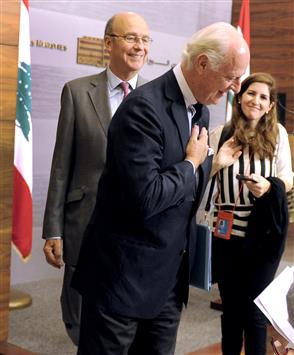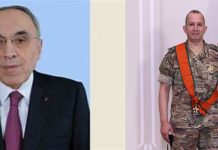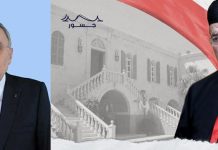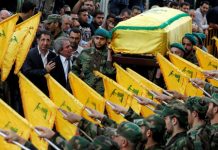The Reality of the de Mistura Plan for Syria
Eyad Abu Shakra/Asharq Al Awsat
Thursday, 18 Dec, 2014
The public relations efforts on behalf of Damascus of former Lebanese government minister Michel Samaha reveal a lot about nature of the Syrian regime. Samaha, who is currently facing trial after being accused of conspiring with Syrian intelligence chief Ali Mamlouk to carry out bombings in Lebanon, made headline news twice before: the first time when he appeared in Paris as Bashar Al-Assad’s PR agent during the Syrian president’s last official visit to France; the second when it was claimed that he was the fixer who arranged the visit of American investigative journalist Seymour Hersh to Hezbollah’s Secretary-General Hassan Nasrallah.
Following these two landmarks in Samaha’s career, he earned himself a position in Bashar Al-Assad’s “inner circle” of PR people. However, what the unfolding of the Syrian crisis has uncovered on the global scene underlines some more, equally-important facts.
First, the Syrian regime has indeed acted as a political post box and errand runner in the service of various global players. It has done so in return for their assistance in ensuring it achieves its sole raison d’etre: survival, at any cost.
Second, the Damascus regime, especially during the reign of Hafez Al-Assad, knew only too well how to manage the priorities that stemmed from its struggle to stay in power, and became skillful in maneuvering to accomplish this while avoiding passing a point of no return with any side that may support it, or at least not object to its actions. Thus, it was keen to maintain “friendly” relations with other Arab states, and allowed some prominent Sunnis to hold senior posts in the government and army despite its tacit strategic alliance with Khomeinist Iran.
Third, Hafez al-Assad never relied on his diplomatic missions and formal channels of communication with other government in his serious relations in major world capitals, but rather on particular people who were connected with the presidency on personal or special interest levels, as was divulged by Wikileaks. These people have offered their services to the regime in much more intimate and sensitive areas than what ordinary diplomatic missions were qualified to do. Sure enough, Assad Sr. had close links with several top expatriate Syrian businessmen and entrepreneurs in the Americas and Europe who have maintained property and businesses in Syria, providing him access at the highest levels in their respective countries of residence, as well as buying him influence with research centers, academics, and PR companies under different guises.
Fourth, Iran is now running the show in Bashar Al-Assad’s Syria. Since 2005, when Syrian troops had to be withdrawn from Lebanon in the aftermath of Rafik Hariri’s assassination, it became clear that an Iran-inspired and controlled security infrastructure was already in place. It is now also the de facto government of Lebanon. Thus, the regime of Assad Jr. has become the main beneficiary of the Obama administration’s decision to join Iran in making extremist takfirist-jihadist Sunni Islam its biggest enemy. The irony here, however, is that extremist Sunni Islam has never been a hurdle for America’s interests in the Middle East. Rather, the opposite was true throughout the Cold War era.
Fifth, Washington knows quite a lot about the role played by Damascus and Tehran in facilitating the flow of extremist jihadists into occupied Iraq after 2003, with the aim of harassing American troops and forcing their withdrawal, which is exactly what happened. Indeed, after these extremists did their job, Damascus and Tehran turned them into bogeyman for America and the West; and now ISIS and the remnants of Al-Qaeda have proven to be Damascus and Tehran’s—formerly the most “steadfast” of anti-Western rulers—best means of gaining Western support and uniting under America’s regional umbrella in its war against terrorism.
All the aforementioned facts are helpful to bear in mind when considering UN Syria envoy Staffan de Mistura’s plan to “freeze” hostilities in and around Aleppo, prior to this being extended to all of Syria’s conflict zones, and as a stepping-stone towards a national process of peace negotiations.
The reality is that the proposed “freeze” idea sounds very much like the much trumpeted local “reconciliations” the Syrian regime has forced on the neighborhoods and city suburbs it has surrounded or blackmailed by cutting off food and medical supplies after failing to retake these areas through conventional militarily means.
Furthermore, the “freeze” idea is said to be the brainchild of a pro-Assad and pro-Hezbollah American-Iranian journalist, who has been Special Adviser for Syria in The Centre for Humanitarian Dialogue’s Middle East and North Africa Regional Office. The Centre for Humanitarian Dialogue (HD) is an organization that claims to be interested in peacemaking, mediation, and humanitarian dialogue, and receives financial aid for its endeavors and plans from countries like Switzerland and Norway.
Today, it is obvious that Assad’s regime has succeeded—thanks to Iranian and Russian help—in turning what began as a peaceful popular uprising into a bloody civil war, causing population displacement and human suffering on a massive scale, and has subsequently asked its agents and its PR machine in America and Europe to portray the whole situation as a “humanitarian crisis.”
Thus, these agents and PR machines are now active in drawing the world’s attention to two humanitarian aspects of the Syrian crisis while overlooking the culprit: the need to reduce the human suffering of Syrian refugee, and confront the threat of extremists to minorities. Regarding the latter, it is worth mentioning the “In Defense of Christians” summit held recently in Washington DC, which sought to “raise awareness about the threats to Arab minorities,” and was financed and organized by wealthy businessmen and activists closely connected to Bashar Al-Assad and Iran.
Those who are aware of the de Mistura plan also point out to those said to compose de Mistura’s “kitchen cabinet” of aides and advisors. They include American, European and Israeli academics, Syrian business figure and Assad functionaries and agents, as well American and Lebanese experts in negotiation tactics.
Among the interesting studies that have provided a useful background to this and similar plans is a report prepared by the Belfer Center for Science and International Affairs at Harvard University’s John F Kennedy School of Government in cooperation with NUPI (The Norwegian Institute of International Affairs) and Trinity University in San Antonio, Texas, entitled Obstacles to a Resolution of the Syrian Conflict.
The common denominator linking the contributors to this Harvard-NUPI-Trinity report, which appeared in November 2013, is that most are close “friends” or virulent supporters of the Syrian president and his regime. This is especially true of Professor David W. Lesch of Trinity University whose bio underlines his close links with Assad, and the Israeli academic Professor Eyal Zisser, who some have described as “Assad’s honorary friend” in Israel. Almost all express sympathy with the regime and strong doubts about the Syrian opposition’s intentions and actions – particularly its Islamist elements – and warn against underestimating the “complex” nature of the crisis.
This is, in short, what one needs to read into the de Mistura plan.
Yet, it has to be said too that such dubious plans would have never hatched had there been international leadership that truly valued freedom, and promoted urgent, efficient, and principled solutions to the Syrian crisis, instead of turning Syria into a trap and its people into bait to attracts the extremists of ISIS.





















